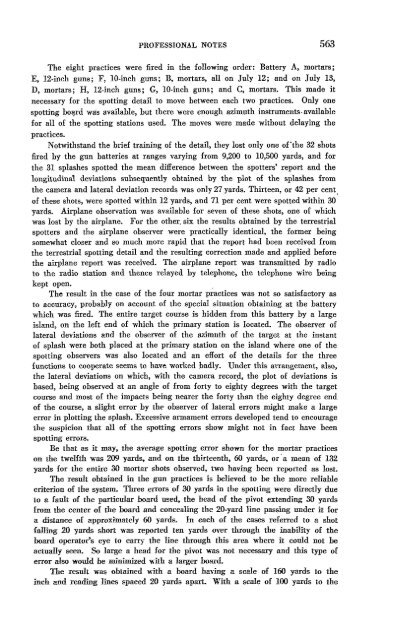COAST ARTILLERY, JOURNAL - Air Defense Artillery
COAST ARTILLERY, JOURNAL - Air Defense Artillery
COAST ARTILLERY, JOURNAL - Air Defense Artillery
You also want an ePaper? Increase the reach of your titles
YUMPU automatically turns print PDFs into web optimized ePapers that Google loves.
PROFESSIONAL NOTES 563<br />
The eight practices were fired in the following order: Battery A, mortars;<br />
E, 12-inch guns; F, lO-inch guns; B, mortars, all on July 12; and on July 13,<br />
D, mortars; H, 12-inch guns; G, 10-inch guns; and C, mortars. This made it<br />
necessary for the spotting detail to move between each two practices. Only one<br />
spotting bo~rd was available, but there were enough azimuth instruments. available<br />
for all of the spotting stations used. The moves were made without delaying the<br />
practices.<br />
Notwithstand the brief traiuing of the detail, they lost only one of' the 32 shots<br />
fired by the gun batteries at ranges varying from 9,200 to 10,500 yards, and for<br />
the 31 splashes spotted the mean difference between the spotters' report and the<br />
longitudinal deviations subsequently obtained by the plot of the splashes from<br />
the camera and lateral deviation records was only 27 yards. Thirteen, or 42 per cent.<br />
of these shots, were spotted within 12 yards, and 71 per cent were spotted within 30<br />
yards. <strong>Air</strong>plane observation was available for seven of these shots, one of which<br />
was lost by the airplane. For the other. six the results obtained by the terrestrial<br />
spotters and the airplane observer were practically identical, the former being<br />
somewhat closer and so much more rapid that the report had been received from<br />
the terrestrial spotting detail and the resulting correction made and applied before<br />
the airplane report was received. The airplane report was transmitted by radio<br />
to the radio station and thence relayed by telephone, the telephone wire being<br />
kept open.<br />
The result in the case of the four mortar p~actices was not so satisfactory as<br />
to accuracy, probably on account of the special situation obtaining at the battery<br />
which was fired. The entire target course is hidden from this battery by a large<br />
island, on the left end of which the primary station is located. The observer of<br />
lateral deviations and the observer of the azimuth of the target at the instant<br />
of splash were both placed at the primary station on the island where one of the<br />
spotting observers was also located and an effort of the details for the three<br />
functions to cooperate seems to have worked badly. Under this arrangement, also,<br />
the lateral deviations on which, with the camera recor~, the plot of deviations is<br />
based, being observed at an angle of from forty to eighty degrees with the target<br />
course and most of the impacts being nearer the forty than the eighty degree end<br />
of the course, a slight error by thl" observer of lateral errors might make a large<br />
error in plotting the splash. Excessive armament errors developed tend to encourage<br />
the suspicion that all of the spotting errors show might not in fact have been<br />
spotting errors.<br />
Be that as it may, the average spotting error shown for the mortar practices<br />
on the twelfth was 209 yards, and on the thirteenth, 60 yards, or' a mean of 132<br />
yards for the entire 30 mortar shots observed, two having been reported as lost.<br />
The result obtained in the gun practices is believed to be the more reliable<br />
criterion of the system. Three errors of 30 yards in the spotting were directly due<br />
to a fault of the particular board used, the head of the pivot extending 30 yards<br />
from the center of the board and concealing the 20-yard line passing under it for<br />
a distance of approximately 60 yards. In each of the cases referred to a shot<br />
falling 20 yards short was reported ten yards over through the inability of the<br />
board operator's eye to carry the line through this area where it could not he<br />
actually seen. So large a head for the pivot was not necessary and this type of<br />
error also would be minimized "ith a larger board.<br />
The result was obtained with a board having a scale of 160 yards to the<br />
inch and reading lines spaced 20 yards apart. With a scale of 100 yards to the
















